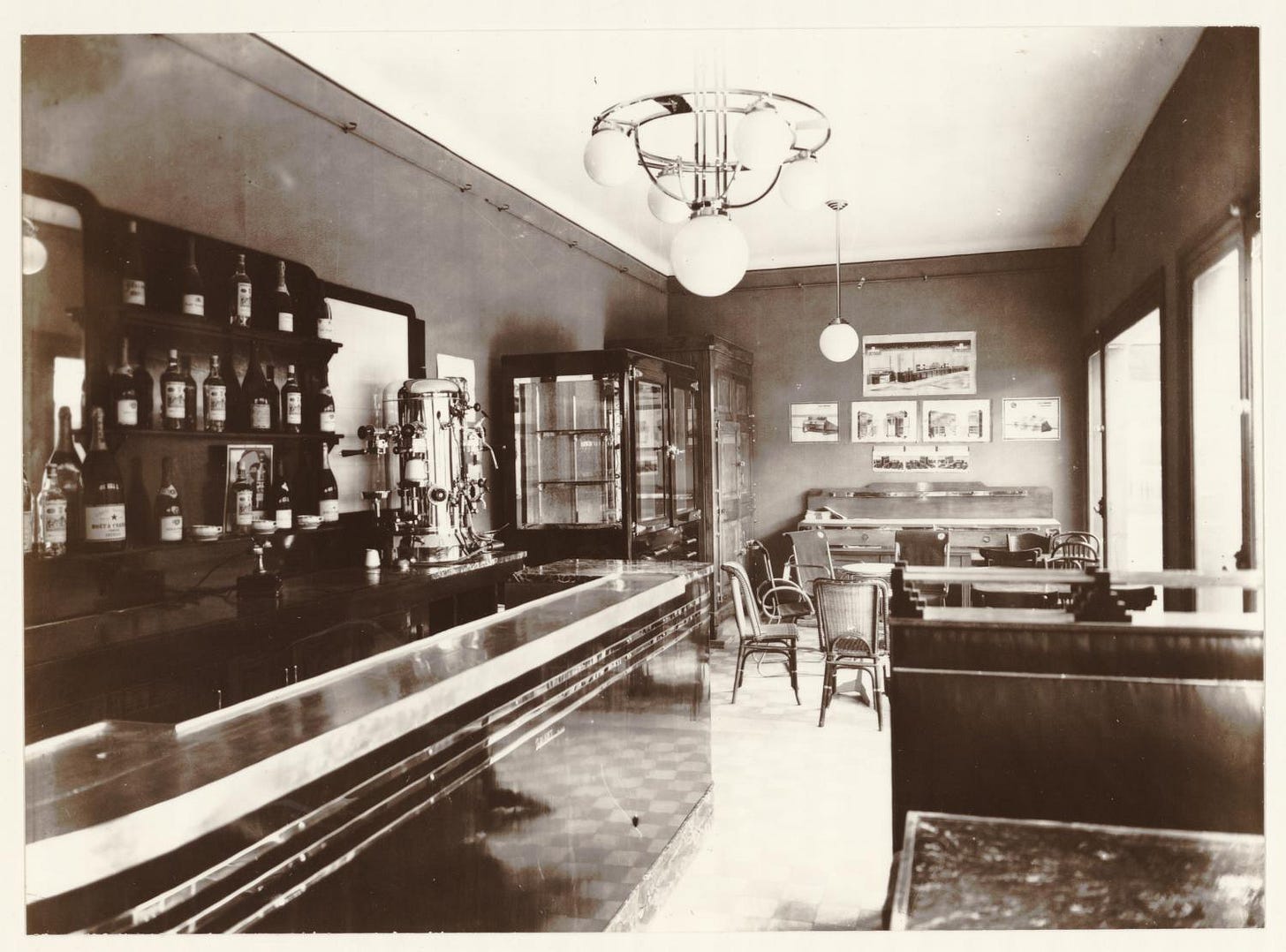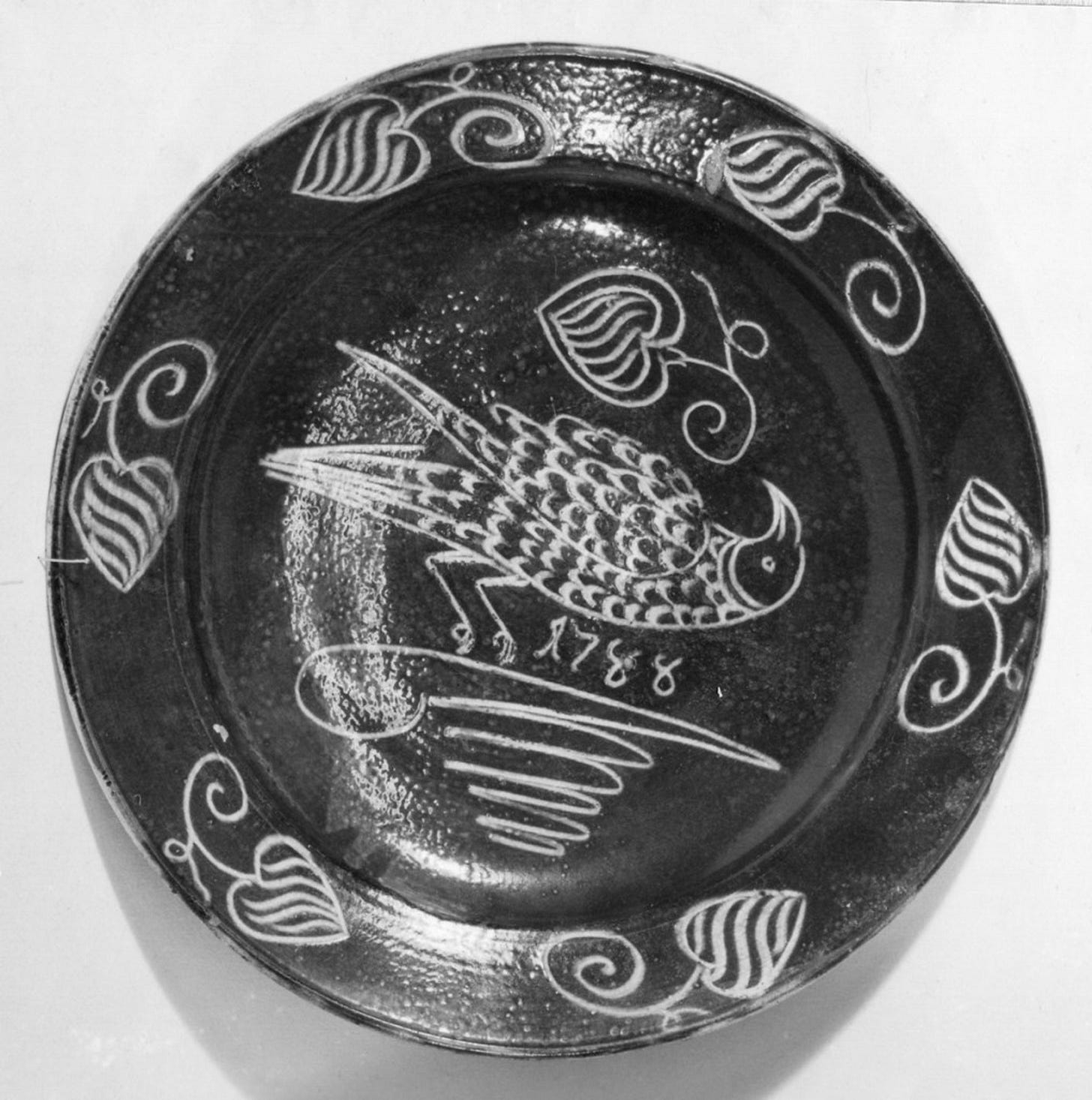“It was dark when we parted ways, and we were friends.”
George Oprescu, “Un grand historien de l’art, ami des Roumains : Henri Focillon”, Revue de Transylvanie, Tome X, 1944.
1921. It was a hot summer day in Lyon. The hazy heat entrapped the city in heavy mugginess from the Rhone River to the top of the Fourvière hill, blurring the outlines of the stately buildings along the boulevards, and winding its way even into the darkest corners of the labyrinthine city centre, through cryptic alleyways and along winding side streets.
The day was slowly fading into the evening when two men exited the Fine Arts museum. Like many of their townsfolk, they were drawn out into the city in the hope of escaping the stuffy air of their offices, seeking tatters of fresh air and the enjoyment of the last hours before dusk. They settled on the terrace of a brasserie and ordered two pints of beer – an obvious choice of beverage given the circumstances.
Jules Sylvestre (1859-1936), Bistrot in Lyon in the 1920s, ca. 1920, P0546 06950, Municipal library of Lyon, France.
As we see them now, they are sitting across from each other, holding pensively onto their glasses, their heads tilted towards one another, brows slightly furrowed as they listen with heartfelt attention to the other’s flow of thought… They are deep in conversation, so deep in fact that the world around them – the hot summer evening, the busy streets of Lyon, the bustle of the waiter taking orders and serving drinks, the miscellaneous chit-chat of the neighbouring tables – has faded away and they are the only two people in the whole world.
But let us pause for a moment : who are our two protagonists ? They are the same age – 40 – but they otherwise have little in common. In the eyes of one of the men, one reads a sincere admiration and a certain deference for his colleague. It is George Oprescu, a French language and literature teacher, art collector, and art historian in the making. He is on a study trip to France with a group of secondary school teachers from Transylvania, organised in the hope, he says, of “eras[ing] in the minds [of the participants] the negative results of the Hungarian school, and that by allowing the Romanians of Transylvania to drink from the same source as those of the Old Kingdom, it would tighten the bond between our brothers across the mountains [i.e the French] and ourselves[1]”. The course on French art delivered to the Transylvanian group is taught by none other than the other man at the table: a certain Henri Focillon, a respected art historian and much loved teacher, director of the Fine Arts museum of Lyon and lecturer at the University of Lyon.
George Oprescu (right) and Henri Focillon (left)
Both men, presently engrossed in each other’s company, will in the coming years profoundly influence the field of art history in their respective countries : Oprescu will practically establish the discipline in Romania, founding in 1949 the Institute of Art History in Bucharest (which now carries his name), setting through his academic research the foundations and the framework for future Romanian art historians, collecting all his life Romanian art both old and new, both folk and fine, and advocating for their recognition abroad.
In these endeavours, he will find in Henri Focillon an infallible supporter. Besides his brilliant academic career (he will hold prestigious teaching positions at the Sorbonne, the Collège de France, Yale University, etc.), Focillon is also to become a “great friend of the Romanians[2]” and an enthusiastic and relentless promoter of Romanian art in France. In 1925, he will curate the exhibition Old and modern Romanian art (Art roumain ancient et moderne) at the Jeu de Paume in Paris - in the words of Oprescu, it was his “efforts [which] ensured the exhibition was a complete success[3]” - and a few years later, he will dedicate a whole chapter of his book Painting in the 19th and 20th centuries : from realism to the present day (La peinture aux XIXe et XXe siècles : du réalisme à nos jours, 1928) to what he calls the “Latins of the Danube”, commending in a few laudatory pages the honest artistic talent of those anonymous folk artists of yore and the modern artists of today :
“[The Romanians] are by nature painters, they have that gift of all gifts, the one that is least controlled, and that the most cunning or fiery aesthetics cannot bring forth from an infertile soil. [...] [In our time], there are many artists who bring their concerns and refinements to the Paris school, from Pallady, […] to Elena Popea, to Iser […]. With talents as flexible and as strong, the Danube Latins belong to what is solid and lively in European painting; they enrich Latinity, like the poets they have given to the French language, with an oriental languor and the most penetrating sensitivity[4].”
Focillon will also leave his mark on the collections on the Fine Arts museum of Lyon, acquiring a few years after his encounter with Oprescu a set of Transylvanian ceramics for the museum. He writes in the preface of the catalogue of the exhibition at the Jeu de Paume that an "ingenuous lyricism expresses itself in vivid and gentle notes on the surface of the pottery, in the hollows of dishes interlaced with arabesques. A carpet, a vase - will we ever know how to make such objects in our Western lands, with our complicated souls and deft hands? [...] It is a world, a whole folklore of clay, a whole cycle of charming fables set in symbolic and sincere strokes by the resounding soul and the skillful hand of the potter-painter[5]”.
Ceramic plate from Transylvania, 1788, d. 27cm - h. 4cm, B 1315-5, Fine Arts museum of Lyon, France.
But all of this is yet to come. Now, they are still sipping beer at the brasserie in Lyon – slowly the terrace empties and dusk sweeps over the street, bringing with it a fresh breeze and the hope of a cool night. Their glasses have been emptied and replenished, and yet their conversation is inexhaustible. Focillon speaks “in a voice that [is] warm, virile, caressing and penetrating at the same time. His sentences, of unequalled perfection, flow […] harmoniously and elegantly, supported by an exceptionally rich vocabulary of the most subtle epithets and the most original judgements[6]”. And Oprescu listens, captivated and in awe : truly, “ [t]his is the way to express oneself when talking about art, with this communicative warmth, this vast general knowledge which, far from imposing its pedantic indiscretion as is too often the case, only shows itself at the right moment, in order to enlighten the listener, to highlight an idea thanks to an allusion, an unexpected connection[7]” !
What we are witnessing now is a rare meeting of minds, a communion of souls, the birth of a lifelong friendship. It is dark now and there is a pause - the content silence that only comes after hours of intense and sincere discussion. They both stand. At that moment, through the warmth of their handshake and the emotion in their eyes, they know in their heart of hearts that they are parting ways bound by a “brotherly bond […] that could only be broken by the death of one of [them][8]”. Around them, the lingering couples on the street, the tired waiter and the last few customers finishing off their drinks sharpen into focus, the quiet bustle of the early night loudens in their ears, the streets are sprinkled with the luminous dots of the streetlights… Both men disappear down the street and from this page, into the history books yet to be written.
Footnotes
[1] George Oprescu, “Un grand historien de l’art, ami des Roumains : Henri Focillon”, Revue de Transylvanie, Tome X, 1944, p. 8.
The region of Transylvania only joined Greater Romania after World War I, on 1st December 1918. Since 1867, it had been part of the Austro-Hungarian Empire.
[2] George Oprescu, “Un grand historien de l’art, ami des Roumains : Henri Focillon”, Revue de Transylvanie, Tome X, 1944.
[3] George Oprescu, “Un grand historien de l’art, ami des Roumains : Henri Focillon”, Revue de Transylvanie, Tome X, 1944, p.11
[4] Henri Focillon, « Les Latins du Danube », in La peinture aux XIXe et XXe siècles : du réalisme à nos jours, 1928.
[5] Henri Focillon, Exposition d’art roumain ancien et modern (cat.), 1925, p.23-24.
[6] George Oprescu, “Un grand historien de l’art, ami des Roumains : Henri Focillon”, Revue de Transylvanie, Tome X, 1944, p. 8-9.
[7] George Oprescu, “Un grand historien de l’art, ami des Roumains : Henri Focillon”, Revue de Transylvanie, Tome X, 1944, p. 8-9.
[8] George Oprescu, “Un grand historien de l’art, ami des Roumains : Henri Focillon”, Revue de Transylvanie, Tome X, 1944, p. 9.
Further reading
Henri Focillon, « Les Latins du Danube », in La peinture aux XIXe et XXe siècles : du réalisme à nos jours, 1928.
George Oprescu, “Un grand historien de l’art, ami des Roumains : Henri Focillon”, Revue de Transylvanie, Tome X, 1944.
Press kit for the exhibition La Vie des formes. Henri Focillon et les arts, Fine Arts museum of Lyon, 2004. Available here.
Previously on The Peripatetic Museum






